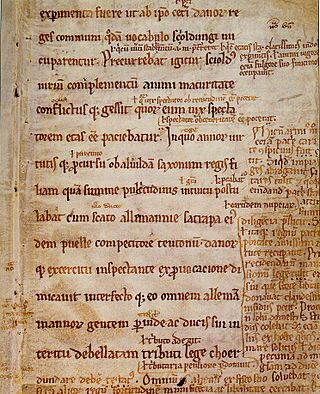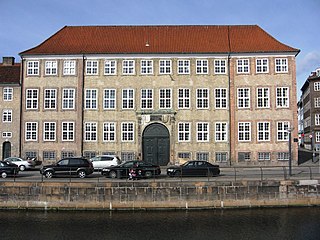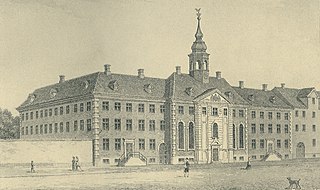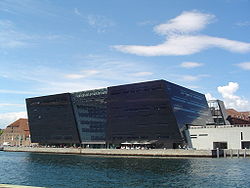
The Angers Fragment (Angersfragmentet) are four parchment pages dating from the 12th-century. They are one of the four fragments remaining of the original Gesta Danorum written by Saxo Grammaticus. This is the only fragment attested to be of Saxo's own handwriting. It consists of four pages with 8 written sides.
The Arnamagnæan Manuscript Collection derives its name from the Icelandic scholar and antiquarian Árni Magnússon (1663–1730) — Arnas Magnæus in Latinised form — who in addition to his duties as Secretary of the Royal Archives and Professor of Danish Antiquities at the University of Copenhagen, spent much of his life building up the collection of manuscripts that now bears his name. The majority of these manuscripts were from Árni's native Iceland, but he also acquired many important Norwegian, Danish and Swedish manuscripts, as well as a number of continental provenances. In addition to the manuscripts proper, the collection contains about 14000 Icelandic, Norwegian and Danish charters, both originals and first-hand copies (apographa). After being housed since Árni's death at the University of Copenhagen, in the Arnamagnæan Institute, under a 1965 parliamentary ruling the collection is now divided between there and the Árni Magnússon Institute for Icelandic Studies in Reykjavík, Iceland.

The Royal Danish Academy of Music, or Royal Danish Conservatory of Music, in Copenhagen is the oldest professional institution of musical education in Denmark as well as the largest, with approximately 400 students. It was established in 1867 as Kjøbenhavns Musikkonservatorium by Niels Gade – who was also the first rector –, J.P.E. Hartmann and Holger Simon Paulli on the basis of a testamentary gift from the jeweler P.W. Moldenhauer, and with inspiration from the Leipzig Conservatory and a conservatory founded by Giuseppe Siboni in Copenhagen in 1827. Carl Nielsen was a teacher in the period 1916–1919 and the rector during the last year of his life.

Reading Room West or The Research Reading Room at The Royal Danish Library is a part of The Danish National Library and is located in Black Diamond, the Royal Library's modern extension on Slotsholmen in Copenhagen. The history of the reading room has its roots in the foundation of The Royal Library by King Frederik III and it has been relocated several times since then.
Johan Ludvig Mansa, was a German-Danish landscape gardener. The majority of his work was in transforming formal French gardens into English landscape gardens. Some remnants of his works can still be seen on the slope north of Marienlyst Castle in Helsingør as well as a few manors and palaces around Denmark.

The Ministry of Culture Denmark is a ministry of the Danish Government, with responsibility for culture, sport and media.
Daniel Gotthilf Moldenhawer, was a German-Danish philologist, theologian, librarian, bibliophile, palaeographer, diplomat, and Bible translator.
The National Museum of Photography is located in the Black Diamond, a modern waterfront extension to the Royal Danish Library in Copenhagen.

The Black Diamond is a modern waterfront extension to the Royal Danish Library's old building on Slotsholmen in central Copenhagen, Denmark. Its quasi-official nickname is a reference to its polished black granite cladding and irregular angles. Designed by Danish architects Schmidt Hammer Lassen, the Black Diamond was completed in 1999 as the first in a series of large-scale cultural buildings along Copenhagen's waterfront.

The Royal Library Garden, often referred to simply as the Library Garden, is a small, somewhat hidden garden between the Royal Library, the Tøjhus Museum, ChristianIV's Supply Depot and Christiansborg Palace on Slotsholmen in central Copenhagen, Denmark. It has a reputation for being one of the most tranquil spots in the city centre.

Royal Danish Library is a merger of the two previous national libraries in Denmark: the State and University Library in Aarhus and the Royal Library in Copenhagen. Although now under a single organisation, the separate locations in both cities are maintained.
Per Højholt was a Danish poet. Højholt had his debut in 1948 when he published "De nøgne", a series of poems which appeared in the magazine Heretica. His first collection was Hesten og solen, featuring religiously inspired poems. A major work came with Poetens hoved which appeared in 1963. This collection took a Modernist stance and meant a break with late Symbolism. Although a highly experimental and unorthodox writer, he became a popular poet. This is not least due to Gittes monologer. He toured the country with his recitals of these monologues which received considerable attention.

The so-called Heart Book is a 16th-century Danish manuscript, now kept in Det Kongelige Bibliotek, Copenhagen.

The Hamburg Bible a manuscript in The Royal Library, Denmark, inscribed in 2011 on UNESCO's Memory of the World Register.
Catalogue of Oriental Manuscripts, Xylographs etc. in Danish Collections (COMDC), is an international scholarly catalogue describing the manuscripts from Asia and North Africa in the Royal Danish Library, the National Museum of Denmark and a few other Danish collections. It is published in collaboration between the Royal Library and the University of Copenhagen, with support from the Carlsberg Foundation.

The State and University Library in Aarhus, Denmark, is a national library and the university library of Aarhus University. It is a research library and the central repository for all Danish public libraries holding millions of items both in print and digital formats including sound and music recordings, videos, journals, books, patents, maps, prints and drawings. The library is directly subordinated the Danish Ministry of Culture and is a legal deposit library, receiving copies of all audio, video and newspapers produced in Denmark.

Erland Kolding Nielsen was Director General and CEO of The Danish Royal Library.

Det Kongelige Vajsenhus is a private primary school in Copenhagen in Denmark. The school has around 300 students and 25 teachers. The school has the right to print Den Danske Salmebog . The school was originally a combined orphanage and school, founded by Frederick IV of Denmark in 1727, and the institution was given a number of privileges, such as the right to manage a factory and a book printing shop. From 1740, it had the right to print Bibles and psalmbooks, and during the 18th century, it was a center for Pietism in Denmark.
The great book theft was the largest book theft in Danish history. Almost 3,200 works, estimated in 2003 to have a value of DKK150-300 million, were stolen from the Royal Library in Copenhagen. The perpetrator was an employee at the library who stole the works between 1970 and 1978, but the case was only resolved in 2003. Most works have since been recovered, but a few hundred remain missing. It has been called the most significant cultural theft in Denmark since the Golden Horns of Gallehus were stolen in 1802.
















